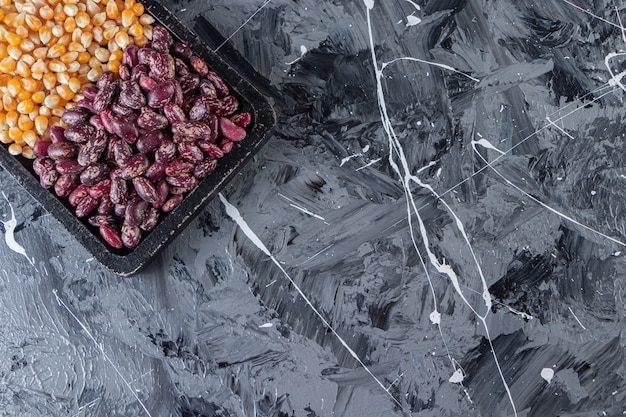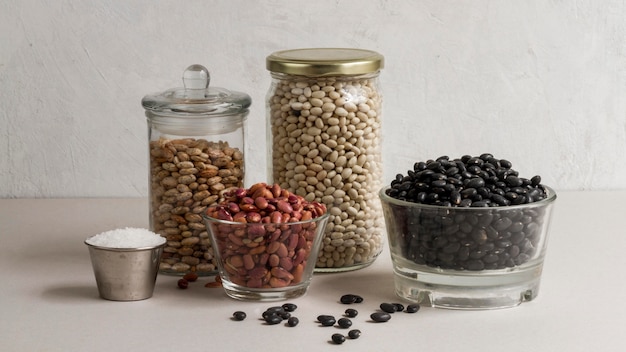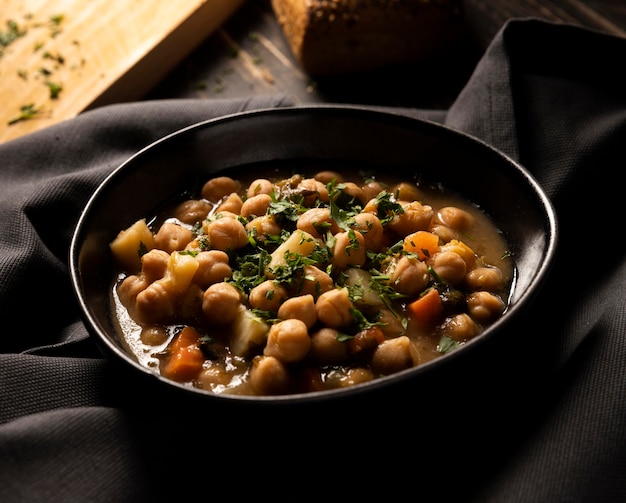Navy beans. They’re one of those unassuming ingredients that can really shine with a little bit of love and attention. You know, the kind of thing that makes you feel like a proper home cook, even if you're just whipping up a simple side dish. I've been making navy beans for years, experimenting with different methods and flavours, and I've finally got a system that works like a charm. So, buckle up, because we're about to dive into the wonderful world of navy beans.
Part 1: Getting Started

The first thing you need to do is choose your beans. You want to look for beans that are firm, plump, and free of any damage. They should have a smooth, even colour, and shouldn't smell musty. Now, some people might tell you to soak the beans overnight, but honestly, I don't bother. I find that a good long simmer does the trick just fine. And besides, I'm usually too impatient to wait overnight!
Washing and Sorting
Once you've got your beans, give them a good rinse. This helps to wash away any dust or debris. Then, take a closer look and pick out any stones or damaged beans. I know it might sound like a chore, but it’s worth it to avoid any unpleasant surprises in your final dish. You’d be surprised how often a little pebble hides amongst the beans.
The Right Pot for the Job
Now, you'll need a decent-sized pot for cooking. A heavy-bottomed pot is ideal, as it will distribute the heat evenly and help prevent scorching. I've got a trusty old enamel cast iron pot that I use for everything from soups to stews, and it's perfect for navy beans. Plus, it gives the beans a lovely, slightly rustic flavour. If you don't have a cast iron pot, don't worry – a stainless steel pot will work just fine. The key is to choose a pot that's large enough to allow the beans to move freely in the water.
Part 2: The Art of the Simmer

Alright, let's get cooking! You'll need about 2 cups of dried navy beans for a good-sized batch. Pour your beans into the pot and add enough water to cover them by a couple of inches. Now, bring the water to a boil, and then reduce the heat to a gentle simmer. This is where the magic happens. A slow simmer allows the beans to cook evenly and absorb all the delicious flavours.
Adding Salt and Seasonings
Now, here's where you can start experimenting with flavours. Don't be afraid to add a generous pinch of salt to the pot – this will help the beans cook evenly and prevent them from becoming mushy. You can also add other seasonings like bay leaves, peppercorns, or a sprig of thyme. Just be sure to add them at the beginning of the cooking process, so they have a chance to infuse the beans with their flavours. You can even experiment with a pinch of smoked paprika for a hint of smokiness or a dash of dried oregano for a touch of Mediterranean flair.
Checking for Doneness
You'll know the beans are cooked when they're tender but not mushy. You can test them by pressing a few against the side of the pot. If they give slightly and release a bit of their starch, they're ready. This usually takes about an hour and a half, but it can vary depending on the age of the beans. You can always add a little more water if the beans start to look dry. Don't be afraid to taste a bean or two as they cook. You'll get a sense of how they’re progressing and you can adjust the cooking time accordingly.
Part 3: Beyond the Basics: Flavour Combinations

Now, let's talk about the fun part: adding flavour to your navy beans! The beauty of these humble beans is that they can go in so many different directions. From smoky and savory to bright and tangy, there's a recipe for every taste bud.
Classic bean soup
For a hearty and comforting bean soup, simply simmer the beans with chopped onions, celery, and carrots. You can add a few diced potatoes for extra substance, and season with salt, pepper, and a dash of dried herbs. A sprinkle of fresh parsley just before serving adds a lovely pop of colour and flavour. I often add a tablespoon of tomato paste for a richer, more complex flavour, and a few sprigs of thyme for a touch of herbaceousness.
Spicy bean salad
For a lighter and more vibrant dish, try making a bean salad. Cook the beans until tender, then drain and toss them with chopped red onion, bell peppers, and fresh cilantro. Add a drizzle of olive oil, a splash of lime juice, and a pinch of cumin for a spicy and refreshing salad. You can also add a handful of chopped black olives and a sprinkle of feta cheese for extra flavour and texture. Don’t be afraid to experiment with different types of peppers – I love adding a little bit of jalapeno for a subtle kick.
Creamy Bean Dip
Want something a little more indulgent? You can use navy beans to make a creamy dip. Blend cooked beans with Greek yogurt, garlic, lemon juice, and a dash of salt and pepper. Serve it with tortilla chips, pita bread, or even raw vegetables. You can also add a dollop of sour cream or a sprinkle of smoked paprika for extra flavour. I love adding a touch of sweetness by mixing in a tablespoon of honey, but this is definitely optional.
Part 4: The Art of Bean Mashing
Now, you might be thinking, "What about mashed beans?" Well, I'm a firm believer in mashed beans, and they're a great way to use up leftover cooked beans. They're incredibly versatile and can be used in a variety of dishes, from simple side dishes to hearty main courses.
The Right Tools for the Job
You can mash beans with a potato masher, a fork, or even a food processor. I prefer to use a potato masher, as it allows me to control the texture of the beans. If you want a super smooth consistency, you can pulse the beans in a food processor. Remember, the key is to get a nice, creamy texture, so don't over-process the beans.
Adding Flavour to Mashed Beans
Mashed beans are a blank canvas for flavour. You can add herbs, spices, garlic, or even a dollop of cream cheese. I like to add a little olive oil and a squeeze of lemon juice for a simple yet delicious side dish. You can also mix in a tablespoon of Dijon mustard for a tangy kick. For a truly decadent treat, try adding a dollop of sour cream or crème fra??che just before serving.
Part 5: Incorporating Navy Beans into Your Meals
Navy beans are like little flavour sponges, soaking up all the deliciousness of the ingredients they're cooked with. They can be a main attraction or a subtle addition to a variety of dishes.
Hearty Soups and Stews
Navy beans are a staple in soups and stews. They add a hearty texture and protein to your dish. They pair beautifully with root vegetables like potatoes, carrots, and celery, as well as leafy greens like kale or spinach. You can add a smoky flavour by adding a bit of bacon or sausage. I love adding a bit of diced smoked ham hock to my navy bean soup for a rich, smoky flavour that really elevates the dish.
Savoury Chilis and Stews
When it comes to chilis and stews, navy beans are real MVPs. Their ability to soak up flavour makes them perfect for simmering in rich, spicy sauces. They can be the star of the show or a supporting player, adding texture and substance to your dish. For a vegetarian chili, I like to use a combination of black beans, kidney beans, and navy beans, along with diced tomatoes, onions, peppers, and a generous amount of chili powder. A sprinkle of smoked paprika adds another layer of flavour depth.
Salads and Sides
Don't limit yourself to just soups and stews. Navy beans can also be a fantastic addition to salads and sides. They add a satisfying crunch and protein to your meal. Try tossing them with fresh herbs, a light vinaigrette, and chopped vegetables for a simple and delicious side dish. I like to add a handful of chopped walnuts or almonds for a nutty crunch, and a squeeze of lemon juice for a bright, tangy flavour.
Baking and Breads
Now, this might surprise you, but navy beans can even be used in baking. They can be added to bread dough to add a bit of protein and moisture. You can also use them to make bean flour, which can be used in cakes, cookies, and other baked goods. I love making a simple navy bean bread using a combination of white and whole wheat flour. The beans add a subtle sweetness and a lovely texture to the bread.
Part 6: The Benefits of Navy Beans
Okay, so we've talked about all the delicious ways to cook navy beans, but did you know they're also incredibly good for you? They're packed with protein, fibre, and essential vitamins and minerals. They're also a good source of iron, which is important for healthy red blood cells.
Dietary Fibre
Navy beans are an excellent source of dietary fibre, which is essential for healthy digestion and can help regulate blood sugar levels. This can help you feel fuller for longer, making them a great addition to any weight-loss plan. The fibre in navy beans also helps to promote a healthy gut microbiome, which plays a crucial role in overall health.
Protein Powerhouse
Navy beans are also a good source of protein, which is important for building and repairing tissues. They're a great option for vegetarians and vegans, as they can help to provide a complete protein profile. This makes them a great choice for those looking for plant-based protein sources.
Heart-Healthy Benefits
Studies have shown that eating beans regularly can help lower cholesterol levels and reduce the risk of heart disease. This is because beans are low in saturated fat and contain soluble fibre, which can help bind to cholesterol in the gut and prevent it from being absorbed into the bloodstream. They’re also a good source of potassium, which helps to regulate blood pressure.
Part 7: Navy bean faqs
You're probably wondering about a few things, so let's get those questions answered.
1. How do I know if my beans are bad?
If your beans smell musty or have any signs of mold, they are not good to eat. You can also check for discoloration or any damage to the beans. If the beans are older, they might have a slightly off-putting smell, but as long as they don't have any visible signs of spoilage, they should be fine to eat.
2. Can I freeze navy beans?
Yes, you can freeze cooked navy beans. Simply transfer them to a freezer-safe container and freeze for up to 3 months. Thaw them overnight in the refrigerator before using. You can freeze navy beans in broth or sauce as well, which makes it easy to use them in soups or stews later on.
3. Can I use canned navy beans instead of dried beans?
You can use canned navy beans if you're in a pinch, but the flavour won't be quite the same. canned beans are often pre-salted, so be sure to adjust the seasonings accordingly. Canned beans are also softer in texture than dried beans, so they’re best used in dishes where texture isn’t a priority, like soups or dips.
4. Can I add too much salt to my beans?
Adding a bit of salt to the cooking water can help the beans cook evenly and prevent them from becoming mushy. However, too much salt can make the beans taste salty and less flavorful. Start with a small amount of salt and adjust to taste. Remember, you can always add more salt later, but you can’t take it out once it’s in.
5. What's the best way to store leftover navy beans?
Store leftover navy beans in an airtight container in the refrigerator for up to 3 days. You can also freeze them for up to 3 months. To make sure the beans stay moist, store them in the broth or sauce they were cooked in.
Part 8: My Favourite navy bean recipes
Now, for the grand finale: my favourite navy bean recipes. These are the ones I keep coming back to, time and time again. Each one is a testament to the versatility of this humble ingredient.
1. Smoky Bean and Chorizo Stew
This stew is packed with flavour, with the smoky chorizo complementing the hearty beans perfectly. It’s a great meal for a cold winter night, and it’s easy to make ahead of time.
| Ingredients | Instructions |
|---|---|
|
|
2. Mediterranean Navy Bean Salad
This salad is light and refreshing, perfect for a summer lunch or dinner. It's full of flavour and texture, with the tangy lemon dressing adding a bright finish.
| Ingredients | Instructions |
|---|---|
|
|
3. Creamy Navy Bean and Spinach Dip
This dip is incredibly rich and creamy, with the spinach adding a subtle earthy flavour. It's perfect for parties or as a snack with tortilla chips or crackers.
| Ingredients | Instructions |
|---|---|
|
|
So there you have it! From simple sides to flavour-packed main courses, navy beans offer endless possibilities in the kitchen. They're budget-friendly, good for you, and incredibly versatile. Get creative, experiment with different flavours, and enjoy the magic of the humble navy bean!
Everyone is watching

Corn on the Cob: The Ultimate Guide to Perfectly Cooked Ears
Healthy MealsAh, corn on the cob. Just the name evokes images of sunny days, barbecues, and that sweet, juicy flavour that ...

Perfect Pork Roast Oven Cooking Time: A Guide to Delicious Results
Healthy MealsThere's something truly satisfying about a perfectly roasted pork. The aroma alone is enough to make your mout...

Scallops: The Ultimate Guide to Perfect Cooking
Healthy MealsAh, scallops. Those delicate, sweet, and utterly delicious morsels of the sea. They hold a special place in my...

Ham Cooking Time: How Long to Bake, Smoke, or Boil a Delicious Ham
Healthy MealsAh, ham. It's a classic, isn't it? A real crowd-pleaser, especially around holidays. And when done right, it'...

Spaghetti Squash: The Ultimate Guide to Cooking and Serving
Healthy MealsRemember that time you saw spaghetti squash at the supermarket, looking all bumpy and strange, and thought, "W...
